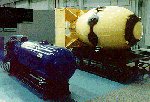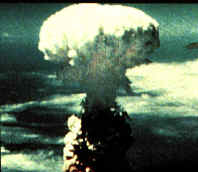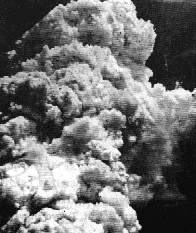
1.Outline of Atomic Bomb
| (I) Hiroshima-type | (2) Nagasaki-type | |
| Length: | 3 meters | 3.2 meters |
| Diameter: | 0.7 meters | Diameter: 1.5 meters |
| Weight: | 4 tons | 4.5 tons |
| Element; | Uranium 235 | Plutonium 239 |
| Energy: | Equivalent to 20 kilotons of TNT in explosive power (However, it has been estimated that the yield was equivalent to approximatelv 1 3 kiloltons.) | |
| The explosion was caused by collision of two parts of critical amounts of uranium compacted in a iong.shaped bomb. The bomb contained 10~30 kg uranium; however the actual fission occurred in the first 1 kg, not leaving time for the rest of the uranium to generate a chain-reaction. | This was contained in a spherical casing, and the plutonium was pushed toward the center by the pressure of surrounding conventional gunpowder. |

The blue bomb was called "little boy" and was dropped on Hiroshima
The yellow one was called "fat man" and was dropped on Nagasaki.
2.Comparison of the Atomic Bomb Damage between Hiroshima and Nagasaki
Hiroshima |
Nagasaki |
|
Height of burst point |
580 |
500 |
Area where roof-tiles melted |
600 m |
1,000 m |
Area where granite stone melted (radius from hypocenter) |
1,000 m |
1,600 m |
3. Fireball at the Instant of Explosion

With the explosion, intense heat rays and radiation were radiated in all directions, and a
blast occurred with the tremendous expansion of the surrounding air. It is estimated that
approximately 35% of the total energy generated was thermal radiation, approximately 50%
blast energy, and approximately 15% radiation energy (5% from initial radiation and
10% from residual radiation).
4. Velocity of Climb of Atomic Bomb Clouds
Height (m) |
Lapse of time after the explosion |
Velocity of climb (km/h) |
3,000 |
48 sec. |
Approximately 320 |
4,500 |
1 mm. 30 sec. |
" 80 |
6,000 |
2min.36sec. |
" 53 |
7,500 |
4min.36sec. |
" 32 |
9,000 |
8min.30sec. |
" 19 |

Mushroom cloud seen from the arsenal at Kasumi-cho (2.7 kilometers southeast. Photographed by Tosbio Fukada.)